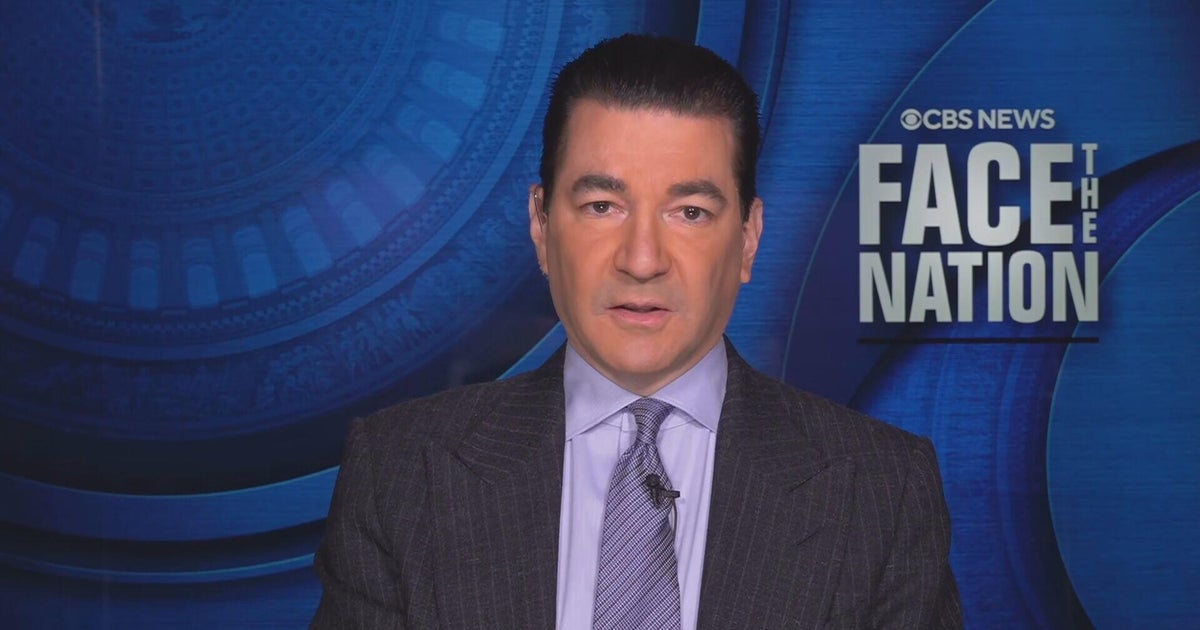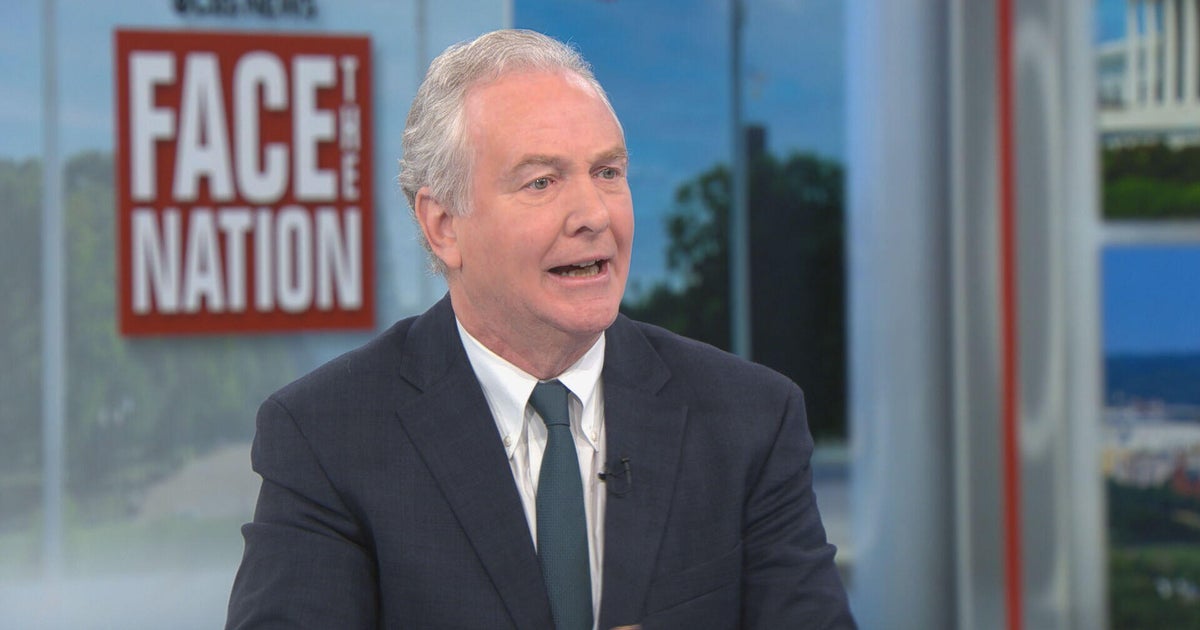Transcript: Scott Gottlieb discusses coronavirus on "Face the Nation," March 14, 2021
The following is a transcript of an interview with former FDA Commissioner Scott Gottlieb that aired March 14, 2021, on "Face the Nation."
MARGARET BRENNAN: We go now to former FDA commissioner Dr. Scott Gottlieb. He sits on the board of Pfizer as well as Illumina, and he joins us from Westport, Connecticut. Good morning to you.
DOCTOR SCOTT GOTTLIEB: Good morning.
MARGARET BRENNAN: So, Dr. Gottlieb, I want to ask you about the mayor of New York who appeared to be disagreeing with Dr. Fauci, because Dr. Fauci said these new variants that they're tracking in New York City are showing resistance to therapies and to the vaccines. The mayor of New York said his health department said that's- that the vaccine works. And in fact, he said we're not seeing reinfection of people who've had it previously. What's going on in New York?
DOCTOR SCOTT GOTTLIEB: Yeah, the trends in New York look concerning right now. If you look at other parts of the country where B.1.1.7, that variant from the United Kingdom that we've been watching, is becoming very prevalent. So Florida, where it's about 50% of infections, Texas, it's about 40% of infections. You're not really seeing an upsurge in infections. You're seeing perhaps a plateauing, but you're not seeing this sort of fourth wave that we feared even as B.1.1.7 starts to take over. In New York City as 15.26, that new New York variant, and B.1.1.7 start to become more prevalent, you are seeing a backup in cases; you're seeing a plateauing. Hospitalizations are still declining slowly, but it's kind of plateaued. New cases are about 3,000 a day. The positivity rate's about 6%. It's been that way for a couple of weeks now. And so you're seeing sort of a backup in New York that you're not seeing in other parts of the country. So there are some concerning trends. Now, with respect to that new variant, that New York variant, 15.26, we are concerned about that. Right now, of the samples being sequenced that have what we call this S gene dropout, so there are samples that we're sequencing because we know they're variants. About 40% of them are this 15.26. And New York is really the only place in the country right now that we know of where it's 15.26 is that much of the infection and about half of those cases. So half of the cases of 15.26 have the same mutation that's in the South African variant, this 484K mutation that could make the virus more impervious to our vaccines. So it is a concern. We also are seeing in with the 1.351, the South African variant, with this same 484K mutation. We're seeing people get re-infected. And so whether or not that's starting to happen in New York and that explains these trends, we don't know yet. It's still early, but there's a lot of reasons to be concerned about the trends in New York City.
MARGARET BRENNAN: From your perspective, is it too soon then for the mayor to be telling people to go back to the office in May, to be telling high schoolers to go back to school in person as soon as next week, to be going back to higher capacity seating in restaurants?
DR. GOTTLIEB: Look, I think we're going to know in the next two weeks where the trends are heading in New York City. It's hard to know for sure which way we're going to head. But right now, the data in New York looks more concerning than other parts of the country. There's other parts of the country that have opened up liberally, have a lot of B.1.1.7 and aren't seeing the same trajectory that New York is. Now, it may just be a- a backup, and we continue with the declines in New York like we're seeing in other parts of the country in the next two weeks, or it may be the start of an upswing. We don't know. I think the next two weeks are really going to be a critical period. I would be cautious in New York because if 15.26. is partially explaining what's going on in New York City, that could be really concerning. There's- there's ways to explain what's happening in New York that aren't as concerning. That mean, you know, this is just sort of a temporary blip and will continue on with declines and then there's ways to explain it that would cause a lot of concerns, including that 15.21- 26 mutation.
MARGARET BRENNAN: So one of the hedges at the end of President Biden's very hopeful speech about COVID was these new variants. He said, we're watching them. But he did put that July Fourth date on the calendar for gathering. Is that a realistic timeline?
DOCTOR SCOTT GOTTLIEB: I think it is. I think most of the country is going to look much better well before that. I think you're seeing cases decline all around the nation, even in parts of the country where 1.1.7, that UK variant, is becoming very prevalent. You're still seeing continued declines, albeit more slowly. I think the combination of a lot of prior infection and the fact that we're vaccinating aggressively now is enough to keep up with that and hopefully get ahead of it. So I think as we get into April, the situation around the country is going to look markedly better. But there will be pockets of outbreaks and there will be pockets where some of these variants become more prevalent that could look bad even though the rest of the nation is going to look very good. And New York is one of those parts of the country right now that if you look at New York, there is some concerning trends there. Even while the other parts of the country are improving, New York does seem to be plateauing. So I think overall, the trajectory for the nation continues to look good.
MARGARET BRENNAN: You've been saying watch Europe as an indicator of what may be happening here. Europe's moving pretty slow on their vaccinations. Italy is looking at a lockdown over- over Easter because of what they're seeing. Should we anticipate that's what's going to happen here?
DOCTOR SCOTT GOTTLIEB: Yeah, through this whole pandemic, we've been about maybe three or four weeks behind Europe, so we've used Europe as a barometer of what's going to happen in the United States. I think the tables have turned and I think we're ahead of Europe because we're vaccinating so much more aggressively. Eastern Europe looks very bad right now. Italy looks bad, but I think the U.K.- the U.S. in a much different situation through a combination of the fact that we have a lot of prior infections, so there's immunity in the population from prior infection, and we've now vaccinated 25% of adults. We're vaccinating probably about 1.5 to two million new people a day. We vaccinated about 65% of those above the age of 65 about 75%- almost 75% this week, above those- above the age of 75. And we're seeing the- the benefits of that. 96% reduction in nursing homes, we've had very good penetration with the vaccine. So I think we're in a different situation than Europe because of the vaccine-induced immunity that we're getting into the population.
MARGARET BRENNAN: Pfizer, where you serve on the board, their CEO said this week that he's seen the vaccine blocks 94% of asymptomatic infections. Is that the final word showing that if you're vaccinated, you cannot spread the virus?
DR. GOTTLIEB: It's an important data point. This comes out of real-world evidence from Israel and all of the evidence across all the vaccines now is pointing in the direction that these vaccines reduce asymptomatic infection and reduce transmission. We've always believed that they're having that effect. We didn't know the full magnitude of that benefit. But all of the incremental evidence coming out suggests that the impact on a reduction in transmission could be quite strong. And if that's the case, the vaccine creates what we call dead-end hosts, a lot of dead-end hosts, meaning people will no longer be able to transmit the infection. And just like you get exponential spread on the way up in an epidemic, if you can get a whole bunch of immunity in people where they can no longer spread the infection, that has a compounding effect on reducing the scope of the epidemic. So if, in fact, this vaccine has a substantial impact on reducing transmission, it's going to become a very important public health tool in controlling the epidemic.
MARGARET BRENNAN: All right, Dr. Gottlieb, thank you for your analysis. We'll be back in a moment.



